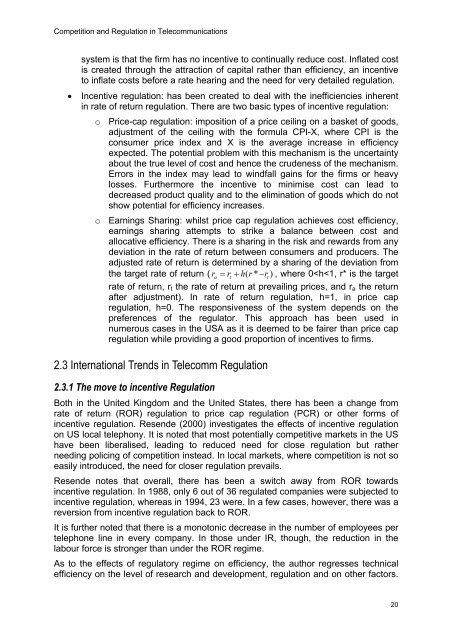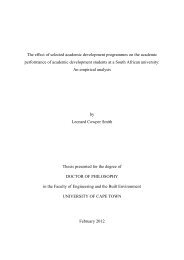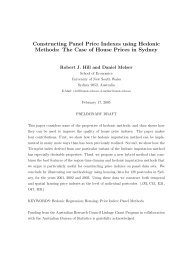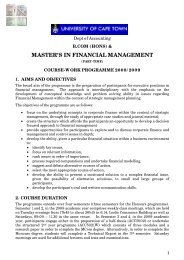Competition and Regulation in the Telecommunications Industry in ...
Competition and Regulation in the Telecommunications Industry in ...
Competition and Regulation in the Telecommunications Industry in ...
Create successful ePaper yourself
Turn your PDF publications into a flip-book with our unique Google optimized e-Paper software.
<strong>Competition</strong> <strong>and</strong> <strong>Regulation</strong> <strong>in</strong> <strong>Telecommunications</strong>system is that <strong>the</strong> firm has no <strong>in</strong>centive to cont<strong>in</strong>ually reduce cost. Inflated costis created through <strong>the</strong> attraction of capital ra<strong>the</strong>r than efficiency, an <strong>in</strong>centiveto <strong>in</strong>flate costs before a rate hear<strong>in</strong>g <strong>and</strong> <strong>the</strong> need for very detailed regulation.• Incentive regulation: has been created to deal with <strong>the</strong> <strong>in</strong>efficiencies <strong>in</strong>herent<strong>in</strong> rate of return regulation. There are two basic types of <strong>in</strong>centive regulation:o Price-cap regulation: imposition of a price ceil<strong>in</strong>g on a basket of goods,adjustment of <strong>the</strong> ceil<strong>in</strong>g with <strong>the</strong> formula CPI-X, where CPI is <strong>the</strong>consumer price <strong>in</strong>dex <strong>and</strong> X is <strong>the</strong> average <strong>in</strong>crease <strong>in</strong> efficiencyexpected. The potential problem with this mechanism is <strong>the</strong> uncerta<strong>in</strong>tyabout <strong>the</strong> true level of cost <strong>and</strong> hence <strong>the</strong> crudeness of <strong>the</strong> mechanism.Errors <strong>in</strong> <strong>the</strong> <strong>in</strong>dex may lead to w<strong>in</strong>dfall ga<strong>in</strong>s for <strong>the</strong> firms or heavylosses. Fur<strong>the</strong>rmore <strong>the</strong> <strong>in</strong>centive to m<strong>in</strong>imise cost can lead todecreased product quality <strong>and</strong> to <strong>the</strong> elim<strong>in</strong>ation of goods which do notshow potential for efficiency <strong>in</strong>creases.o Earn<strong>in</strong>gs Shar<strong>in</strong>g: whilst price cap regulation achieves cost efficiency,earn<strong>in</strong>gs shar<strong>in</strong>g attempts to strike a balance between cost <strong>and</strong>allocative efficiency. There is a shar<strong>in</strong>g <strong>in</strong> <strong>the</strong> risk <strong>and</strong> rewards from anydeviation <strong>in</strong> <strong>the</strong> rate of return between consumers <strong>and</strong> producers. Theadjusted rate of return is determ<strong>in</strong>ed by a shar<strong>in</strong>g of <strong>the</strong> deviation from<strong>the</strong> target rate of return ( ra = rt + h( r* − rt), where 0
















